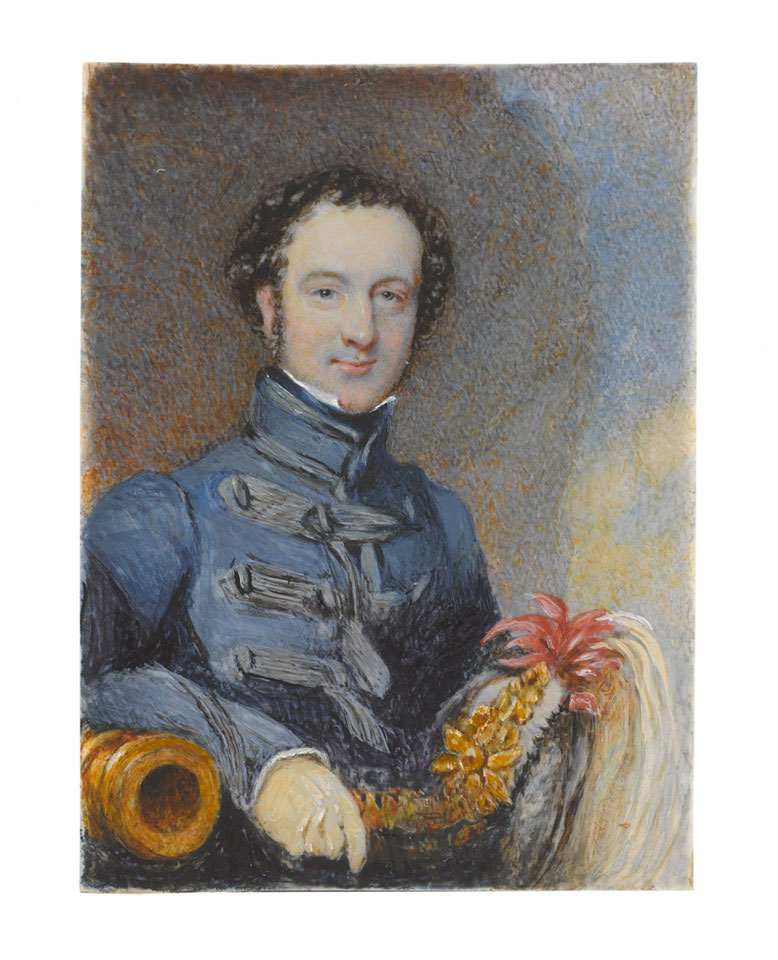
Online Collection
« Prev - 1 of 1 results - Next »
Captain William Siborne, 1830 (c)
Miniature portrait on ivory, after Samuel Lover (1797-1868), 1830 (c).
As a young Ensign William Siborne (1797-1849) served with the 9th Foot from 1815 to 1817 as part of the Army of Occupation in Paris. During this period he developed a strong interest in surveying and topographical modelling and later published two books upon the subject. In 1824 he was gazetted Lieutenant in the 47th Foot and between 1826 and 1843 served as Assistant Military Secretary to the successive Commanders-in-Chief in Dublin. Early in this period he suggested that official support be given to the construction of a model of the battlefield of Waterloo, especially as the historic area was threatened by housing developments and much of the ground was being altered by the construction of the Lion Mound commemorating the Prince of Orange.
In 1830 Siborne obtained official approval for his project from Lord Hill, the Commander-in-Chief of the British Army. He took leave and set off for Waterloo where he lodged for eight months at the farm of La Haye Sainte, making a detailed survey of the battlefield. With Hill's permission he sent out a circular letter to surviving British Waterloo officers. This asked them where their units had been at 'about 7pm', what enemy formations were to their front, what the crops were like in their vicinity and inviting further comments about the parts played by their Regiments. Siborne seems to have received about 700 replies (only 200 of which were later published by his son in his Waterloo Letters) and work on his model began.
The project was initially funded through Lord Hill's office and all went well until 1833, when a change in government meant that patronage abruptly ceased. Committed to the project, Siborne resolved to carry on at his own expense; a decision he was later to regret. As his debts mounted he was forced to contact his correspondents and solicit donations towards the cost of construction. The model was built in Ireland and in 1838 it was finally completed. It was shipped to England in 39 sections and assembled for display to the public in the Egyptian Hall, Piccadilly, London. The model attracted an estimated 100,000 visitors, paying one shilling a head. However, receipts barely covered the hire of the hall and local expenses, leaving Siborne seriously out of pocket. The model was returned to Ireland in 1841 and placed in storage. In 1851, two years after Siborne's death, a subscription was raised by the British regiments depicted on the model and the model was purchased and brought back to London for display in the Banqueting Hall, Whitehall as part of the Royal United Services Museum. In 1962 the Royal United Services Institute had to vacate its museum premises and as no site could be found for the model it was placed in storage. Now the model has found a permanent home at the National Army Museum and, unlike 1838, visitors do not have to pay to see it!
In 1844 Siborne published his History of the War in France and Flanders in 1815 and, undaunted by the financial failure of his first model, launched a new project to complete six new models depicting earlier events in the battle. These were to be on a larger scale, much smaller in size and were to show only parts of the battlefield. In the event only one was completed - showing the repulse of D'Erlon's Corps by Uxbridge's Heavy Cavalry, with 7,000 inch-high figures. This new model was displayed at the Egyptian Hall in late 1844. Again Siborne failed to recoup his costs and, after a long period of storage in Ireland and the Tower of London the model was placed on display in Dover Castle.
NAM Accession Number
NAM. 2016-08-2-1
Copyright/Ownership
National Army Museum, Out of Copyright
Location
National Army Museum, Conflict in Europe gallery
Object URL
https://collection.nam.ac.uk/detail.php?acc=2016-08-2-1

